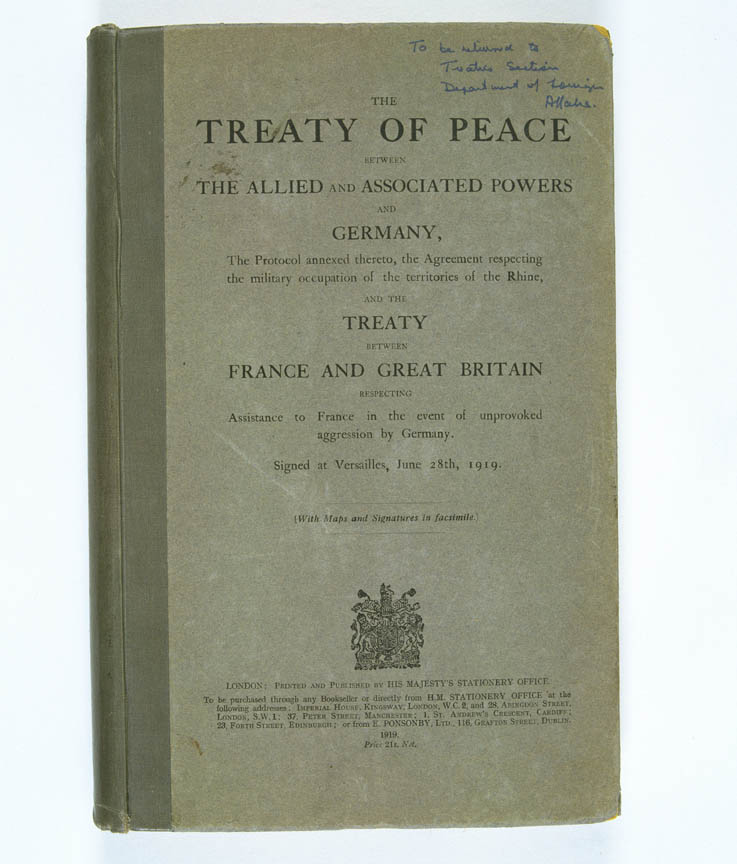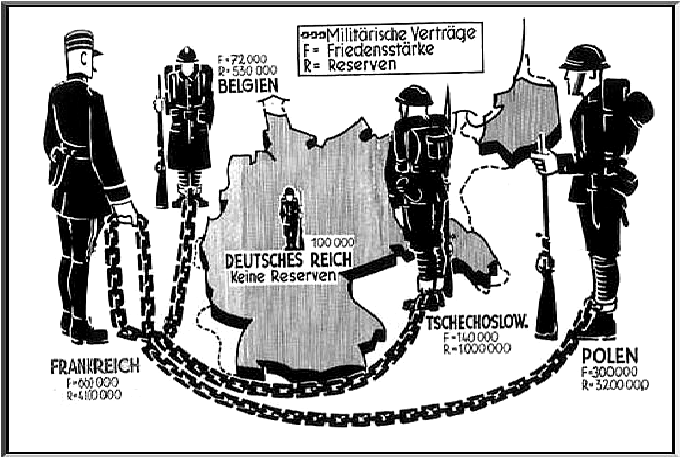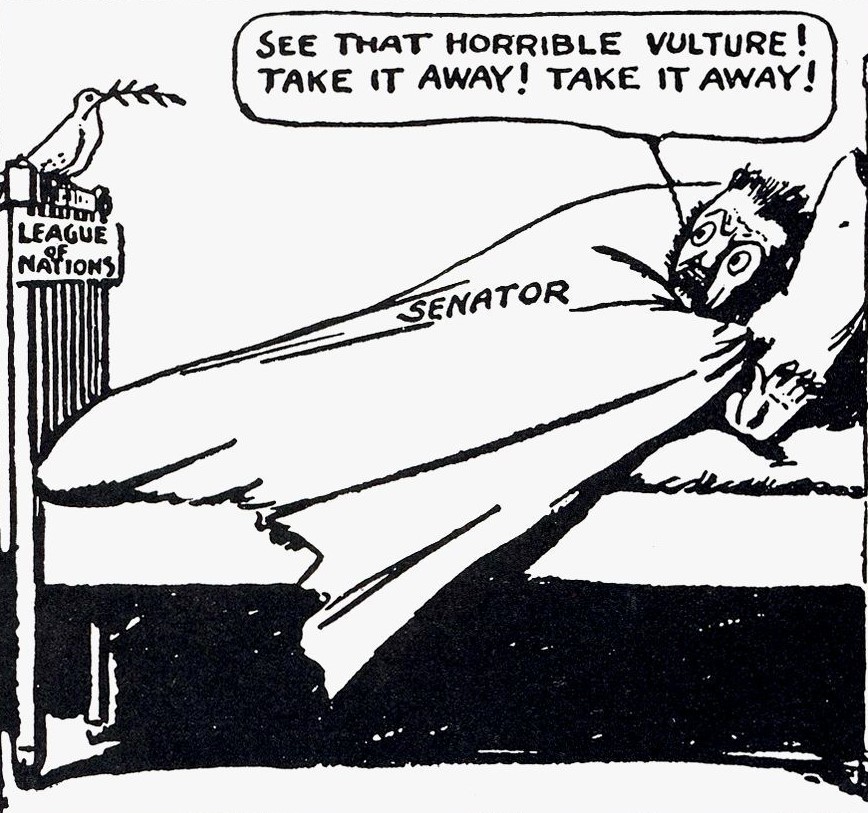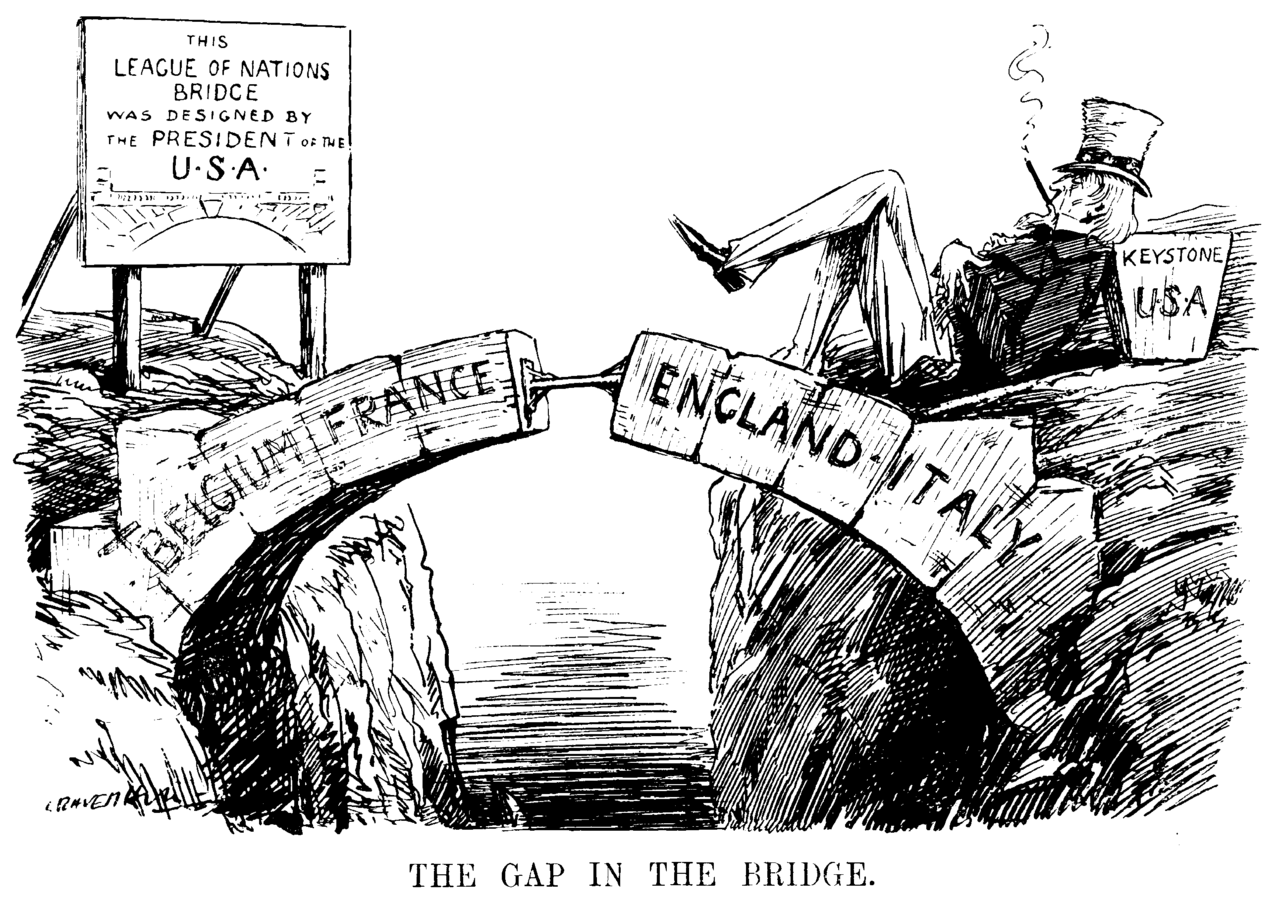
"Treaty of Versailles Front," Museum of Australian Democracy, 1919
The Big Three composed the Treaty of Versailles after almost a year of negotiations. When concluded, the treaty formed the League of Nations, a world organization to prevent war among countries. Germany was shocked by the vindictive communication in the Treaty, especially in articles 119, 160, 231, and 232.
"Those who sign this treaty, will sign the death sentence of many millions of German men, women and children."
- Brockdorff-Rantzau, German Delegatate at Versailles (1919)
Covenant of the League of Nations
President Wilson’s idealistic dream of a new world order revolved around the League of Nations. Based on his Fourteen Points, the League was to be, “a general association of nations must be formed under specific covenants for the purpose of affording mutual guarantees of political independence and territorial integrity to great and small states alike.” The covenant of the League stated, “any war or threat of war, whether immediately affecting any of the Members of the League or not, is hereby declared a matter of concern to the whole League, and the League shall take any action that may be deemed wise and effectual to safeguard the peace of nations.” (Clemenceau, Lloyd George, and Wilson 1919, Covenant of the League of Nations)

"Wilson and League of Nations Cartoon," Heritage Images, 1919
Its function was to prevent wars and provide a communication system to resolve international disputes.
Article 119

"Germany's Territory Losses in Europe," United States Holocaust Memorial Museum, circa 2000
Article 119 stripped Germany of its colonies. Before WWI, a European power required colonial possession; Germany met those requirements, holding a dominant position in the world. However, this article's communication, “Germany renounces in favor of [the Allies] all her rights and titles over her oversea possessions,” (Clemenceau, Lloyd George, and Wilson 1919, Article 119) ended German dominance, letting France and Britain dominate. Other articles took parts of Germany’s land in Europe, crippling Germany.
Article 160

"Comparing Germany's Strength to Surroundings," Alpha History, 1919
Article 160 reduced Germany’s army from 1.9 million soldiers to 100,000 volunteers and ordered the military, "[...] shall be devoted exclusively to the maintenance of order within the territory and to the control of the frontiers..." (Clemenceau, Lloyd George, and Wilson 1919, Article 160) This article communicated terms, requiring Germany not to fight again; benefiting those fearing Germany, including France.
Article 231
Article 232
To justify reparations, the Allies included Article 231, known as the “War-Guilt Clause.” The article communicated “[Germany] will make compensation for all damage done to the civilian population of [the Allies] and to their property during the period of the belligerency of each as an Allied or Associated Power against Germany by such aggression by land, by sea and from the air, and in general all damage…" (Clemenceau, Lloyd George, and Wilson 1919, Article 231)
This article demanded reparations; however, Germany saw it dishonorable. In article 232, the Allies demanded Germany, “[...] Germany accepts the responsibility of Germany and her allies for causing all the loss and damage to which [the Allies] have been subjected as a consequence of the war imposed upon them by the aggression of Germany and her allies...” (Clemenceau, Lloyd George, and Wilson 1919, Article 232) to pay reparations of 132 billion German marks ($33 Billion).
The treaty outraged Germany, who trusted Wilson's Fourteen Points for peace. A German delegate, Brockdorff-Rantzau, stated, “this fat volume was quite unnecessary. They could have expressed the whole thing more simply in one clause–Germany renounces its existence.” (Brockdorff-Rantzau 1919)
Germany wanted revision of peace terms; however, They were ignored. The Allies feared violence since WWI was not officially over. By June 28, 1919, Germany was coerced into signing the treaty under Allies’ invasion threat.
"Treaty of Versailles Terms Interview," Discovery UK, 2019
US Reaction

"Seein' Things," Brooklyn Eagle, 1919
Before taking effect, the treaty needed signatory states’ ratification. A US problem was Congress not seeing the treaty as important as President Wilson expected. Article X of the covenant, “the Members of the League undertake to respect and preserve as against external aggression the territorial integrity and existing political independence of all Members of the League. In case of any such aggression or in case of any threat or danger of such aggression the Council shall advise upon the means by which this obligation shall be fulfilled,” (Clemenceau, Lloyd George, and Wilson 1919, Covenant of the League of Nations) got the US to fear future wars and demand revision.
Strength of rejection increased, but President Wilson wanted the League to remain unchanged and sought support, “For, I tell you, my fellow citizens, I can predict with absolute certainty that within another generation there will be another world war if the nations of the world do not concert the method by which to prevent it.” However, Congress overturned Wilson’s League and Treaty. This meant the League’s communication efforts were already impaired by the rejection of the creator, the US.

"The Gap in the Bridge," Punch Publications, 1919